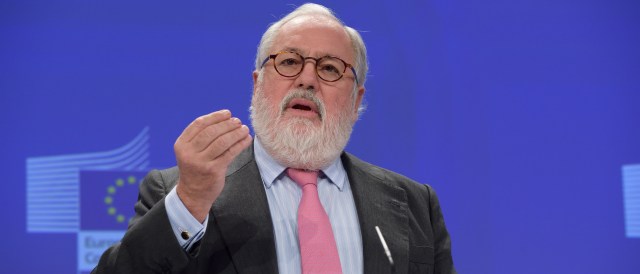Instead of dealing with more pressing issues, Europe’s new energy commissioner Cañete wants to eradicate differences in power prices across Europe. In reality, equal prices are not only impossible to achieve, but make no economic sense, says Jan Ondřich.

Big words, little substance. (© European Union, 2014)
The new energy commissioner, Arias Canete, has been in his post for just a few weeks, and already he has produced enough hot air to inflate a Zeppelin.
In an interview with the Financial Times on November 13, Mr Canete stated that harmonising energy taxes and regulated network charges is the key to achieving a truly single European energy market. He points to vast differences in end user prices as the problem to be fixed.
There are indeed great differences in end user prices across the EU. For example, power bills of Bulgarian households are half those of Austrian households, and one quarter those of Danish households (€304/MWh in Denmark, €202/MWh in Austria, €83/MWh in Bulgaria in the first half of 2014, according to Eurostat).
So Mr Canete is right about the differences. But he is wrong to make their eradication his Holy Grail. His determination to do so will involve him and his team being buried under thousands upon thousands of pages of national regulation, and devoting his entire term as commissioner in trying to harmonise taxes and regulatory frameworks. This is something member states will never agree to in any case.
This exercise in futility could actually harm European energy markets. These markets need less new regulation and more physical interconnection. They need common, simpler and more transparent market rules, not a single end user price.
There is no reason why there cannot be different prices in one efficiently functioning market. There are legitimate reasons for prices to vary. For example, generation in one area is cheaper than in another because of fuel or grid availability. Likewise, consumption is cheaper in one area than another because demand is not constrained by grid insufficiencies.
The fact that prices are the same in two areas tells us nothing about the freedom and efficiency of those markets.
For example, nobody would doubt that the PJM market in the Northeast of the U.S. and Nordpool of Europe are efficient and competitive single market areas. In each case, the rules foster price discovery and generate scarcity price signals in areas of grid or generation constraints by producing different prices from areas with plentiful grid and generation capacity. By doing so, these markets provide clear signals for investment into new grids, new generation or demand response/reduction methods.
Forceful top-bottom harmonisation of end user price simply for the sake of creating one power price is reminiscent of COMECON. Such an approach will serve only to obscure wholesale market pricing signals, and to hinder incentives for more investment into grids, generation and demand efficiency.
Jan Ondřich is a partner in market analysis and advisory firm Candole Partners. He is a regular contributor to this blog.